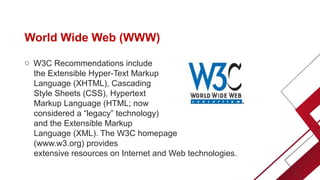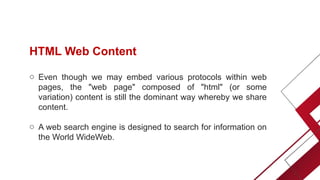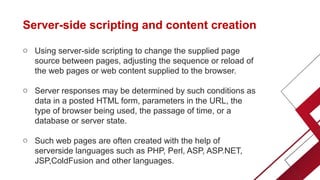Web Application Programming with HTML 5 part 2
- 2. INTERNET o The Internet is a global network of networks that enables computers of all kinds to directly and transparently communicate and share services throughout the world. In 1969 the precursor of Internet is born: ARPAnet. ARPA = Advanced Research Projects Agency was sponsored by the American Department of Defense (DOD).
- 3. INTERNET o It was designed to connect military research centers. It is a distributed computer system able to survive a nuclear attack. In 1970, ARPA starts developing the Transmission Control Protocol / Internet Protocol (TCP/IP), a technology for connecting networks of different types (produced by different companies). Other networks appear, such as CSNET and BITNET.
- 4. FEATURES OF THE INTERNET o Mailing lists o Newsgroups o FTP (File Transfer Protocol) o Telnet or remote login o Chatrooms
- 5. World Wide Web (WWW) o The World Wide Web allows computer users to locate and view multimedia-based documents (i.e., documents with text, graphics, animations, audios or videos) on almost any subject.
- 6. World Wide Web (WWW) o In 1990, Tim Berners-Lee of CERN (the European Laboratory for Particle Physics) developed the World Wide Web and several communication protocols that form the backbone of the Web. The Internet and the World Wide Web surely will be listed among the most important and profound creations of humankind.
- 7. World Wide Web (WWW) o W3C Recommendations include the Extensible Hyper-Text Markup Language (XHTML), Cascading Style Sheets (CSS), Hypertext Markup Language (HTML; now considered a “legacy” technology) and the Extensible Markup Language (XML). The W3C homepage (www.w3.org) provides extensive resources on Internet and Web technologies.
- 8. Web Content o Web content is the textual, visual or aural content that is encountered as part of the user experience on websites. o It may include, among other things: text, images, sounds, videos and animations.
- 9. HTML Web Content o Even though we may embed various protocols within web pages, the "web page" composed of "html" (or some variation) content is still the dominant way whereby we share content. o A web search engine is designed to search for information on the World WideWeb.
- 10. Types of Website Content o Static Web Site o Dynamic Web Site
- 11. Static Web Site o A static web page (sometimes called a flat page) is a web page that is delivered to the user exactly as stored. o Consequently a static web page displays the same information for all users. o Static web pages are often HTML documents stored as files in the file system and made available by the web server over HTTP. o Static Web pages are very simple in layout and informative in context.
- 12. A Static Webpage A theme park website
- 13. A Static Webpage An E-library Website
- 14. A Static Webpage An E-Learning Website
- 15. Advantages of Static Website o No programming skills are required to create a static page. o Inherently publicly cacheable. o No particular hosting requirements are necessary. o Can be viewed directly by a web browser without needing a web server or application server.
- 16. Disadvantages of Static Website o Any personalization or interactivity has to run client-side which is restricting o Maintaining large numbers of static pages as files can be impractical without automated tools
- 17. Application Areas of Static Website: o Changes to web content is infrequent o List of products / services offered is limited o No advanced online ordering facility is required o Features like order tracking, verifying availability of stock, online credit card transactions, are not needed. o Web site not required to be connected to back-end system
- 18. Dynamic Web Sites o A dynamic web page is a kind of web page that has been prepared with fresh information for each individual viewing. o It is not static because it changes with the time, the user, the user interaction, the context or any combination of the foregoing.
- 19. A Dynamic Web Page Online shopping website
- 20. A Dynamic Web Page Workload Automation and Job Scheduling Website
- 21. Two Types of dynamic web sites o Client-side scripting and content creation o Server-side scripting and content creation
- 22. Client-side scripting and content creation o Such web pages use presentation technology called rich interfaced pages. Client-side scripting languages like JavaScript or ActionScript, used for Dynamic HTML (DHTML) and Flash technologies respectively, are frequently used to orchestrate media types of the presentation. o The Client-side content is generated on the user's computer. o The web browser retrieves a page from the server, then processes the code embedded in the page (often written in JavaScript) and displays the retrieved page's content to the user.
- 23. Server-side scripting and content creation o Using server-side scripting to change the supplied page source between pages, adjusting the sequence or reload of the web pages or web content supplied to the browser. o Server responses may be determined by such conditions as data in a posted HTML form, parameters in the URL, the type of browser being used, the passage of time, or a database or server state. o Such web pages are often created with the help of serverside languages such as PHP, Perl, ASP, ASP.NET, JSP,ColdFusion and other languages.
- 24. Application areas of Dynamic Website o Need to change main pages more frequently to encourage clients to return to site. o Long list of products / services offered . o Need for more sophisticated ordering system with a wide variety of functions. o Tracking and offering personalized services to clients. o Facility to connect Web site to the existing back-end system
- 25. Web Browsers o A web browser is a software program that allows a user to locate, access, and display web pages. In common usage, a web browser is usually shortened to "browser.“ o Web browsers are used primarily for displaying and accessing websites on the internet, as well as other content created using languages such as Hypertext Markup Language (HTML) and Extensible Markup Language (XML). o Browsers translate web pages and websites delivered using Hypertext Transfer Protocol (HTTP) into human-readable content.
- 26. Web Browsers
- 27. Web Servers o A web Server is a program that automatically downloads pages from the Web o An application server works with a Web server to handle requests for dynamic content, such as servlets, from Web applications. o The web server software offers access to documents stored on the server. o Clients can browse the documents in a web browser.
- 28. Web Servers
- 29. Web Technologies o HTML, which stands for Hypertext Markup Language, is the predominant markup language for web pages. It is written in the form of HTML elements consisting of "tags" surrounded by angle brackets within the web page content. o It allows images and objects to be embedded and can be used to create interactive forms. It provides a means to create structured documents by denoting structural semantics for text such as headings, paragraphs, lists, links, quotes and other items.
- 30. Web Technologies o HTML can also be used to include Cascading Style Sheets (CSS) to define the appearance and layout of text and other material and Javascript to define the functionality of the website.
- 31. Web Page Addresses (URLs) o URL is the abbreviation of Uniform Resource Locator and is defined as the global address of documents and other resources on the World Wide Web. The Parts of A URL o A complete URL is generally made up of three components: the protocol, the site name, and the absolute path to the document or resource
- 32. The Parts of A URL The first thing the URL does is define the protocol that will be used for that particular transaction. The letters HTTP let the server know to use Hypertext Transfer Protocol, or get into “web-mode.”
- 33. The Parts of A URL The next portion of the URL identifies the web site by its domain name. In this example, the domain name is jendesign.com. The “www.” part at the beginning is the particular host name at that domain. The host name “www” has become a convention, but is not a rule. In fact, sometimes the host name may be omitted.
- 34. The Parts of A URL This is the absolute path to the requested HTML document, first.html. The words separated by slashes indicate the pathway through directory levels, starting with the root directory of the host, to get to first.html
- 35. The Anatomy of a Web Page
- 36. Assignment: • List down all tags with start tag and end tag with description: • List down all tags without end tags with description: • Handwritten and to be submitted on February 7: • Write in a short bond paper, make it clean and neat: • Put it in Expandable plastic Folder for all class.
Editor's Notes
- #15: A cacheable response is an HTTP response that can be cached, that is stored to be retrieved and used later, saving a new request to the server. Like for example yung facebook so kahit offline ka makikita mo yung dating mga info or data na nakastore na sa cache memory.



































